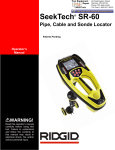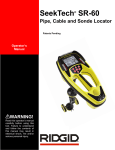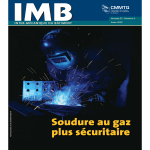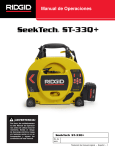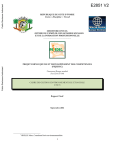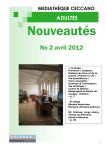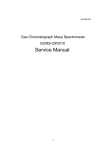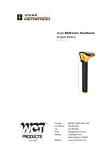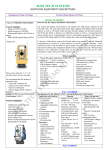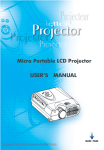Download RIDGID NaviTrack 10 Operator`s manual
Transcript
99 Washington Street Melrose, MA 02176 Phone 781-665-1400 Toll Free 1-800-517-8431 Visit us at www.TestEquipmentDepot.com SeekTech ST-510 ® 10 Watt Pipe and Cable Line Transmitter Operator’s Manual WARNING! Read this operator’s manual carefully before using this tool. Failure to understand and follow the contents of this manual may result in electrical shock, fire and/or serious personal injury. SeekTech ST-510 Line Transmitter Table of Contents GENERAL SAFETY INFORMATION........................................................................................................................ 2 TRANSMITTER COMPONENTS .............................................................................................................................. 5 KEYPAD ................................................................................................................................................................... 6 DISPLAY SCREEN ..................................................................................................................................................... 6 GETTING STARTED ................................................................................................................................................. 7 INSTALLING/CHANGING BATTERIES ............................................................................................................................ 7 OPERATION TIME ..................................................................................................................................................... 7 OPTIONAL EXTERNAL POWER SOURCE...................................................................................................................... 7 POWERING UP/DOWN ............................................................................................................................................... 8 SOUNDS OF THE SEEKTECH TRANSMITTER ................................................................................................................ 8 USING THE ST-510 LINE TRANSMITTER .............................................................................................................. 8 DIRECT CONNECT METHOD .................................................................................................................................. 9 USEFUL OPERATING POINTS ................................................................................................................................... 11 INDUCTIVE CLAMP................................................................................................................................................ 12 INDUCTIVE MODE.................................................................................................................................................. 12 FEATURES.............................................................................................................................................................. 13 48’ (16M) COIL CORDS ........................................................................................................................................... 13 AUTO BACK LIGHT .................................................................................................................................................. 13 HIGH VOLTAGE INDICATOR...................................................................................................................................... 13 MAIN MENU ........................................................................................................................................................... 13 BATTERY SAVER MODE .......................................................................................................................................... 14 AUTO SHUT OFF ADJUSTMENT ................................................................................................................................ 14 OTHER MANUFACTURERS MENU ............................................................................................................................. 15 ADJUSTING THE LCD SCREEN CONTRAST ............................................................................................................... 15 USEFUL INFORMATION ........................................................................................................................................ 16 RESISTANCE AND IMPEDANCE ................................................................................................................................. 16 USING HIGH AND LOW FREQUENCIES ...................................................................................................................... 16 FCC LIMITS ........................................................................................................................................................... 17 TRANSPORTATION AND STORAGE ............................................................................................................................ 17 MAINTENANCE AND CLEANING ................................................................................................................................ 17 SERVICE AND REPAIR ............................................................................................................................................. 17 TROUBLE SHOOTING GUIDE .................................................................................................................................... 19 SPECIFICATIONS................................................................................................................................................... 18 FREQUENCIES ....................................................................................................................................................... 20 EXACT FREQUENCIES ............................................................................................................................................ 20 MANUFACTURERS FREQUENCY TABLE (SEE PAGE 14).............................................................................................. 20 WARRANTY ............................................................................................................................................................ 23 SeekTech ST-510 Line Transmitter ® SeekTech ST-510 Line Transmitter SeekTech® ST-510 Line Transmitter Record the Serial Number and Software Version of your unit below and retain for your records. Serial Number Software Version Test Equipment Depot - 800.517.8431 - 99 Washington Street Melrose, MA 02176 - TestEquipmentDepot.com SeekTech ST-510 Line Transmitter General Safety Information WARNING Read and understand all instructions. Failure to follow all instructions listed below may result in electric shock, fire, and/or serious personal injury SAVE THESE INSTRUCTIONS! Battery Precautions • • • Work Area Safety • • • Keep your work area clean and well lit. Cluttered benches and dark areas may cause accidents. Do not operate electrical devices or power tools in explosive atmospheres, such as in the presence of flammable liquids, gases, or heavy dust. Electrical devices or power tools create sparks, which may ignite the dust or fumes. • • • • • Do not attach the leads to a high voltage line. Do not operate the system with electrical components removed. Exposure to internal parts increases the risk of injury. Avoid exposure to rain or wet conditions. Keep battery out of direct contact with water. Water entering electrical devices increases the risk of electric shock. Use only in the manner specified. Protection provided by the equipment may be impaired if used in a manner not specified by the manufacturer. Do not open the transmitter case. High voltages are present and no serviceable parts are available. Recharge batteries with charging units specified by the battery manufacturer. Using an improper charger can overheat and rupture the battery. Properly dispose of the batteries. Exposure to high temperatures can cause the battery to explode, so do not dispose of in a fire. Some countries have regulations concerning battery disposal. Please follow all applicable regulations. Personal Safety • • Keep bystanders, children, and visitors away while operating tool. Distractions can cause you to lose control. Electrical Safety Use only the size and type of battery specified. Do not mix cell types (e.g. do not use alkaline with rechargeable). Do not use partly discharged and fully charged cells together (e.g. do not mix old and new). • • • • • Avoid Traffic. Pay close attention to moving vehicles when using on or near roadways. Wear visible clothing or reflector vests. Such precautions may prevent serious injury. Stay alert, watch what you are doing and use common sense. Do not use tool while tired or under the influence of drugs, alcohol, or medications. A moment of inattention while operating tools may result in serious personal injury. Gloves should always be worn for health and safety reasons. Sewer lines are unsanitary and may contain harmful bacteria and viruses. Do not overreach. Keep proper footing and balance at all times. Proper footing and balance enables better control of the tool in unexpected situations. Use safety equipment. Always wear eye protection. Dust mask, non-skid safety shoes, hardhat, or hearing protection must be used for appropriate conditions. Use proper accessories. Do not place this product on any unstable cart or surface. The product may fall causing serious injury to a child or adult or serious damage to the product. Prevent object and liquid entry. Never spill liquid of any kind on the product. Liquid increases the risk of electrical shock and damage to the product. SeekTech ST-510 Line Transmitter SeekTech Line Transmitter Use and Care • Use equipment only as directed. Do not • operate the transmitter unless proper training has been completed and the owner’s manual read. • • • • • • • • Do not immerse the antennas or case in water. Store in a dry place. Such measures reduce the risk of electric shock and equipment damage. Store idle tools out of the reach of children and other untrained persons. Tools are dangerous in the hands of untrained users. Maintain tools with care. Properly maintained tools are less likely to cause injury. Check for breakage of parts, and any other conditions that may affect the transmitter’s operation. If damaged, have the tool serviced before using. Many accidents are caused by poorly maintained tools. CAUTION Remove batteries entirely before shipping. Keep handles dry and clean, and free from oil and grease. Allows for better control of the tool. Protect against excessive heat. The product should be situated away from heat sources such as radiators, heat registers, stoves or other products (including amplifiers) that produce heat. must be performed only by qualified repair personnel. Service or maintenance performed by unqualified repair personnel could result in injury. • Damage to the product that requires service. Remove the batteries and refer servicing to qualified service personnel under any of the following conditions: o If liquid has been spilled or objects have fallen into product; o If product does not operate normally by following the operating instructions; o If the product has been dropped or damaged in any way; o When the product exhibits a distinct change in performance. Use only accessories that are recommended by the manufacturer for your tool. Accessories that may be suitable for one tool may become hazardous when used on another tool. Service • Tool service • Conduct a safety check. On completion of service or repair of this product, ask the service technician to perform checks to determine the product is in proper operating condition. When servicing a tool, use only identical replacement parts. Follow instructions in the maintenance section of this manual. Use of unauthorized parts or failure to follow maintenance instructions may create a risk of electrical shock or injury. Provide proper cleaning. Remove batteries before cleaning. Do not use liquid cleaners or aerosol cleaners. Use a damp cloth for cleaning. DANGER The ST-510 transmitter is intended for use with a SeekTech locator/reciever. SeekTech locators are diagnostic tools that sense electromagnetic fields emitted by objects underground. They are meant to aid the user in locating these objects by recognizing characteristics of their field lines and displaying them on the screen. As electromagnetic field lines can be distorted and interfered with it is important to verify the location of underground objects before digging. Exposing the utility is the only way to verify its existence, location and depth. Ridge Tool Co., its affiliates and suppliers, will not be liable for any injury or any direct, indirect, incidental or consequential damages sustained or incurred by reason of the use of the SeekTech ST-510. SeekTech ST-510 Line Transmitter Note: Connection To Energized Conductors European Frequency Set The line transmitter is designed to withstand up to 240 VAC 50/60 Hz excitation between the two leads. The user is cautioned not to deliberately connect to live power lines. The protection is not intended to be used continuously. If the transmitter indicates the presence of high voltage, use high voltage precautions to carefully disconnect the line transmitter from the high voltage source. The Seektech ST-510 as delivered in Europe is slightly different than the ST-510 delivered in U.S. Markets. The line transmitter is normally powered by internal batteries, and is designed to protect the user from voltages up to 240 VAC that may be accidentally encountered. Powering the line transmitter by batteries provides the highest level of isolation and safety, and is therefore the recommended power source. 93 Kilohertz Frequency Use The line transmitter may also be powered by an optional external power supply. The user must ensure that the external power source is fully isolated from ground and from the power mains. The user is cautioned to use only external power sources recommended by the manufacturer. If a line transmitter is powered by an external source that is not isolated from ground and from the power mains, the line transmitter is not protected from connection to live power lines! The line transmitter may be destroyed and may present a safety hazard. DO NOT USE NON-ISOLATED POWER SUPPLIES WITH THE LINE TRANSMITTER. If you find that your transmitter signal at 93 kHz cannot be detected by your receiver, set the transmitter’s frequency to 93-B kHz, which is set to the older value. Both 93 and 93-B frequencies can be found under the Manufacturer’s Menu. (See page 20.) Wear appropriate heavy soled footwear as you would when working with any high-voltage equipment. DANGER If the line transmitter is powered by a vehicle 12 VDC cigarette lighter connection, and the line transmitter is connected to a power line, the vehicle is now connected to that power line. The vehicle is now at a potentially lethal voltage. If the vehicle is grounded, the line transmitter may be destroyed. European frequencies are limited to 95 KHz. The version of the ST-510 for European markets has a top frequency of 93 KHz. The U.S. version has a 262 kHz frequency capability. The default 93 kHz frequency has an actual cycle count of 93,696 cycles per second. Some older transmitters use a different value for the nominal 93 kHz frequency, 93,622.9 cycles per second. DANGER ALWAYS HOOK UP LEADS FIRST BEFORE POWERING THE UNIT ON TO AVOID SHOCK. ALWAYS TURN UNIT DISCONNECTING LEADS. OFF BEFORE ELECTRIC SHOCK MAY RESULT FROM FAILURE TO CONNECT LEADS BEFORE POWERING THE UNIT ON. Do not handle the transmitter while you are connected directly to ground yourself. Test Equipment Depot - 800.517.8431 - 99 Washington Street Melrose, MA 02176 FAX 781.665.0780 - TestEquipmentDepot.com SeekTech ST-510 Line Transmitter Transmitter Components Keypad Lead Clip Pocket Display Screen Shoulder Strap Handle Coil Cord (48 ft.(16m) extended) Back View Top View Bottom View Figure 1: ST-510 Components SeekTech ST-510 Line Transmitter SeekTech Keypad TM )) ) Display Screen Inductive Mode On/Off Use Up/Down Arrows for Output Current Adjustment and Menu Control Keys Orientation For Inductive Mode Select Main Menu (Hold down, use up/down for contrast adjustment) ) )) Frequency Selection Sound On/Off Power On/Off Frequencies High Voltage Indicator 128Hz 1kHz 8kHz 33kHz/ 262kHz Figure 2: Keypad Display Screen Watts Voltage Audio Battery Level )) ) Manufacturer Frequency Current Strength Omhs (resistance) Figure 3: Display Screen • • • • • • Battery Level - Shows remaining battery power in 5 steps. Manufacturer – Shows the manufacturer’s frequency set being used (default is SeekTech). Voltage – Voltage that is applied to the leads. This may say MAX, indicating the voltage is at its highest allowable point (~80 V peak-to-peak, ~30V RMS (square wave.)) Current Strength – This is the current flowing through the circuit in milliamps (mA). Sound – Indicates if sound is ON or OFF. Ohms (resistance) – This shows the approximate resistance in the circuit. See page 16. • Watts (Power) – Total power that the transmitter is putting out. In Battery Saver mode, this is absent. • Frequency – Frequency being used. SeekTech ST-510 Line Transmitter Getting Started Installing/Changing Batteries To install batteries into the ST-510 Line Transmitter, turn the knob on the battery holder counter clockwise. The battery carriage will pull out slightly. Pull straight back on the knob to slide out. Insert the batteries as shown on the inside decal. Fit the carriage into the case and turn the knob clockwise while lightly pushing in to close. The battery carriage can be installed in either orientation. Operation Time Typical operation time for the SeekTech line transmitter, using alkaline cells, is about 12.5 hours which varies depending on factors such as load and current transmitted, and how much the backlight is on. Select the Battery Saver feature if extended battery life is needed. Other factors that affect the operation time will include chemistry of the battery. (Many of the new high performance batteries, such as the “Duracell ® ULTRA” do last 10%-20% longer than conventional alkaline cells under high demand applications). Operation at low temperatures will also reduce battery life. Typical operating times will be generally on the order of those shown here. Note that Battery Saver mode limits output current to 100 mA. Estimated Operating Times Current Est. Time to Depletion 400 mA 1.8 hours 200 mA 3.6 hours Figure 4: Inserting Battery Holder 100 mA 7.25 hours Note: When replacing batteries use 8 D cells that are the same type. Do not mix Alkaline with NiCd (NiCad or Nickel Cadmium) for example. Be sure to replace with batteries where all of the cells have the same amount of charge. Do not mix half-used alkalines with brand new ones. 50 mA 14 hours 25 mA 28 hours CAUTION Always remove batteries before shipping the unit. CAUTION Do not allow debris or moisture into battery compartment. Debris or moisture may short the battery contacts, leading to rapid discharge of the batteries, which could result in electrolyte leakage or risk of fire. Batteries can recover after being subjected to high loads. If time is allowed, batteries may recover enough to offer additional hours of operation. Optional External Power Source Use only a power supply approved to IEC 61010-1 or IEC 60950. Output must be isolated, SELV and Limited-Energy Circuit per IEC 61010-1 or LPS per IEC 60950, 12-15VDC, 30W minimum. Output connection is standard barrel plug, 2.1mm pin, tip positive. SeekTech ST-510 Line Transmitter DANGER If the line transmitter is powered by a vehicle 12 VDC cigarette lighter connection, and the line transmitter is connected to a power line, the vehicle is now connected to that power line. The vehicle is now at a potentially lethal voltage. If the vehicle is grounded, the line transmitter may be destroyed. • Short Buzz on shifting into inductive mode. • Double-beeps operation. during inductive mode To mute the sound, press the Sound key. SeekTech TM )) ) Powering Up/Down Power the unit ON by depressing the Power key on the keypad. The SeekTech logo displays and the software version number and mode will appear at the bottom. An ascending tone sounds. Note: The software version should be noted in the manual and provided with any service request for the unit. It is the first number on the lower left of the startup screen. See form on page 1. )) ) Figure 5: ST-510 Startup Screen Power the unit OFF by depressing and releasing the Power sounds. key on the keypad. A descending tone ) )) Figure 6: Sound Key (Highlighted) Using the ST-510 Line Transmitter The SeekTech ST-510 line transmitter is part of Ridgid’s SeekTech cable and pipe locating system. The ST-510 is used to energize a pipe or line with an “active” signal, so that the underground line may be traced with a compatible receiver. This allows the line’s location to be correctly marked so it can be exposed for repair or avoided during excavation. The ST-510 line transmitter can apply an active tracing signal to a target conductor in three ways: Direct Connect – The receiver’s leads are connected directly to the target conductor or tracing wire, and a suitable ground. Sounds of the SeekTech Transmitter Sounds are associated with specific events. Inductive Clamp (optional) – The jaws of the inductive clamp encircle the target conductor; there is no metal-to-metal contact. They include: • • Ascending/Descending On/Off. Beeps – Power Beeps upon connection. The unit will beep, then pause to measure how much current is flowing onto the cable or pipe. The unit will beep faster when more current is detected. Inductive (internal coils) – The transmitter is placed over and in-line with the utility . Its internal coils generate a field which induces current in the underground target conductor. SeekTech ST-510 Line Transmitter DANGER Always connect leads before turning the transmitter on to avoid electrical shock. Ensure transmitter is well grounded. Direct Connect Method 1. Attach the ST-510 line transmitter to the ground and to the target line. Remove the ground spike from the bottom of the unit and insert it into the ground. Connect one of the cable leads to the grounding spike. The leads are universal, so either may be used. Figure 9: Alternative Connection to a Pipeline DANGER NEVER CONNECT TO LINES ENERGIZED WITH A POTENTIALLY DANGEROUS ELECTRICAL CURRENT. To increase safety, the ground lead should be attached first. If there were an unknown high voltage running through the target line, this would allow a means of redirecting the current away from the transmitter and operator. ALWAYS HOOK UP LEADS FIRST BEFORE POWERING THE UNIT ON TO AVOID SHOCK. ALWAYS TURN UNIT OFF BEFORE DISCONNECTING LEADS. Figure 7: Attaching Lead to Ground Stake 2. Connect the other lead to the target conductor. 3. Select a Frequency The ST-510 line transmitter provides five frequencies: SeekTech TM )) ) 128Hz 1kHz 8kHz ) )) 33kHz/262kHz Figure 8: Example of Connecting to a Gas Line Figure 10: Frequency Selection Note: For 262 Hz, press the 33 kHz button a second time. (In European versions, this will set the unit to 93 kHz). SeekTech ST-510 Line Transmitter 4. Check the Circuit SeekTech More current gives a stronger signal. Less current prolongs battery life. Signal strength measured by the receiver is directly proportional to the amount of current on the line. More current means a stronger signal will be received by the receiver. )) ) To prolong battery life and reduce the chance of the signal “bleeding over” onto adjacent lines, use the minimum amount of current needed to get a clear reading on the receiver. Look at the ohms (Ω) (resistance), the voltage (V) and the current (mA) displayed on the screen. Generally the lower the ohms (total resistance) the more efficiently current can be added. Lower total resistance indicates an efficient circuit and requires less voltage to illuminate the line. TM ) )) Figure 12: Current Selection (Up and Down Arrows) There are 7 current levels that the user can choose from: 5, 25, 50, 100, 200, or 400 mA. )) ) )) ) Figure 11: Display Panel Note: Ohms, current, power and voltage displayed are approximate values. The transmitter will beep faster if the resistance is lower, and slower if the resistance is higher. See notes about Resistance and Impedance on page 16. 5. Adjust Current Figure 13: Current Selected When a current level is chosen, the transmitter will adjust the voltage to try and produce the selected current and lock it in. If the transmitter cannot produce the current selected it will adjust down to the next level. The transmitter’s maximum current output depends on the amount of resistance in the circuit. When the transmitter is putting out the maximum current possible for internal and external conditions, MAX will be displayed in place of the current strength number. Use the up and down arrows to adjust the amount of current in milliamps (mA). )) ) Figure 14: MAX Current MAX will also appear if the power output of the transmitter is at its allowable limit. (See FCC limits in the Useful Information sectionon page 17.) When the current drops below 5 mA, “LO” will appear instead of a number. Test Equipment Depot - 800.517.8431 - 99 Washington Street Melrose, MA 02176 FAX 781.665.0780 - TestEquipmentDepot.com SeekTech ST-510 Line Transmitter )) ) Figure 15: LO Current Useful Operating Points • The lower the total resistance, the more current will be put on the line. A good circuit is one that allows enough current to flow so that the locator gets a clear and stable signal. • WARNING If the transmitter is showing low or no current, the signal may be too low to be detected by the receiver locator and inadequate for tracing. • 6. Check the Receiver Set the receiver’s frequency to match that on the transmitter. Confirm the receiver is picking up the transmitted frequency by holding it near the transmitter and observing the increase in receiver signal. • • • To help lower the resistance of the circuit, scrape away dirt, paint and corrosion before connecting to the target conductor or grounding spike. A good ground lowers resistance, which allows more current flow and a stronger signal. For a better connection to ground, insert the grounding spike as far as possible. Moist ground is a better conductor than dry soil. Wetting the ground can improve a circuit in dry soil. If the desired current output cannot be produced, the voltage and ohms (resistance/impedance) readings can give useful information. For example, if the transmitter is putting out a high voltage, the resistance/impedance of the circuit is probably too high. If the voltage is lower (30v max) and the ohms (resistance) reading is also low, the line transmitter may be constrained by power restrictions. (See FCC limits information on page 17) The transmitter’s leads can act as antennas, broadcasting a strong signal. If locating close to the transmitter, keep the leads as short as possible by stowing the excess length in the transmitter’s side pockets. This will reduce the amount of interfering signals from the leads. It is usually best to start by using the lowest frequency and the least amount of current needed to effectively illuminate the line. Lower frequencies travel farther. Higher frequencies generally make it easier to illuminate a line, but they do not travel as far and are much more likely to couple onto other utility lines. This can distort the signal and reduce accuracy. DANGER ALWAYS HOOK UP LEADS FIRST BEFORE POWERING THE UNIT ON TO AVOID SHOCK. ALWAYS POWER UNIT OFF BEFORE DISCONNECTING LEADS. SeekTech ST-510 Line Transmitter Inductive Clamp Method Figure 16: Inductive Clamp (Optional) 1. Plug the inductive clamp into the 1/4" phone jack above the battery cover. Plug must be mono or, if stereo, connected between tip and base. The coil cords are disabled when the clamp is connected. 2. Clamp the jaws of the Inductive Clamp around a section of the pipe or cable to be traced. Figure 17: Orientation to the Conductor (Inductive Mode) 2. Push the inductive mode (upper right) button to induce a signal onto the line. The Inductive Mode message will appear on the screen. SeekTech TM )) ) 3. Power the transmitter on and proceed as in the Direct Connect method. Be sure the receiver and the transmitter are set to the same frequency. Orientation Mark Inductive Mode The ST-510 can be used without a direct connection to a pipe or cable. In Inductive Mode, the ST-510 generates a field which induces a current into a conductor such as a pipe running directly beneath it. Inductive Key ) )) 1. Be sure that the transmitter is positioned correctly over the line. Figure 18: Inductive Mode Key 3. Lower frequencies couple poorly inductively. When using Inductive Mode, use higher frequencies in order to get a good signal at the receiver. 4. Note that the line into which current is induced must be grounded in both directions for a signal to be induced away from the transmitter. 5. The transmitter in inductive mode will generate a field through the air around it as well as into the ground under it. If the receiver is within about 20-30 feet of the transmitter it will SeekTech ST-510 Line Transmitter measure this field instead of on the target conductor. Place the transmitter at least 20 feet away from the region where tracing occurs in order to avoid this “air coupling”. Figure 20: Storing Leads: Right Way and Wrong Way To avoid tangled cords, “feed” the cords back into the pockets when storing, lead end last. Figure 19: Air Coupling 6. Generally if you trace a line with an induced signal checking for a valid depth measurement and a strong stable proximity signal is the best way to confirm that you are locating the induced signal in a line and not the signal directly from the transmitter through the air (air coupling). Note: If you have been using the ST-510 in inductive mode, be certain to switch inductive mode off if you are going to use the unit in direct connect mode. Air coupling can create very confusing signals if you inadvertently have the unit set to inductive mode but are trying to use it in direct connect mode. Features 48’ (16m) Coil Cords (Extended) The leads of the ST-510 are specially designed, hybrid copper and stainless steel, aircraft-grade coiled cables. They can be stretched out to offer more freedom in choosing grounding points and connections to the line. The further out they are extended, the more incidental signal they can send out; accordingly, the receiver should be used further away from the transmitter to avoid being misled by the cords acting as antennas. Note: Avoid over-stretching the coil cords as they may not fully retract, and become difficult to store in pockets. They can extend to 48’ (16m) readily. If they are extremely warm they may take a while longer to contract fully after full extension. Auto Back Light The SeekTech is equipped with an automatic LCD backlight. Whenever a key is pressed, the backlight is activated to aid viewing for 80 seconds. High Voltage Indicator When ever the line transmitter encounters voltage higher than about 42 volts (RMS), it will flash a red LED at the bottom of the keypad. The LCD will display “High Voltage”. If this occurs, follow highvoltage safety procedures to disconnect the transmitter. SeekTech TM )) ) ) )) Figure 21: High Voltage Indicator SeekTech ST-510 Line Transmitter SeekTech Main Menu TM )) ) To access the Main Menu: 1. Press the menu key: SeekTech TM Select Key )) ) ) Menu Key ) )) )) Figure 25: Select Key Battery Saver Mode Figure 22: Menu Key 2. Use the Up and Down keys to scroll through the menu choices in either direction. This allows the user to limit the power output of the ST-510 line transmitter to approximately 1 watt in order to prolong the life of the batteries. In many cases 1 watt of power is all that is needed. Using the unit with up to 10 watts allows for more power to be used, but consumes the batteries much faster. Battery Saver is off by default. )) ) Figure 23: Main Menu Choices SeekTech )) Up Key )) Figure 26: Battery Saver and Auto-Off Options Auto Shut Off Adjustment TM ) ) )) ) Down Key Figure 24: Up and Down Keys 3. To accept the highlighted choice, press the Select key. Check this box to have an automatic shut down of the transmitter. When checked, using the select key, the ST-510 will automatically shutdown to help conserve batteries. Shutdown time using this feature varies with current draw. The approximate values are: 8 hrs 25ma output or less 4 hrs 50-100ma 2 hrs 200-400ma 1hr >400ma This feature prevents the batteries from running down if the unit is inadvertently left on. Auto Shutoff is on by default. See Figure 26 above. SeekTech ST-510 Line Transmitter Other Manufacturers Menu This menu allows you to use the ST-510 to transmit on different manufacturer’s frequencies. This is convenient if you are using a locator/receiver other than a SeekTech (the default setting). Simply choose the manufacturer of the intended receiver and frequencies for that system will be loaded and available. See the Manufacturer’s Frequencies table on page 20. )) ) Low Med Low Med High High Figure 29: Frequency Buttons Figure 27: Manufacturers Menu Selection Adjusting the LCD Screen Contrast This selection brings up the list of manufacturers. )) ) LCD contrast is set at the factory and should not normally require adjustment. Optimal contrast is set when the background remains white, while the black pixels are set to be as dark as possible. Note: The LCD can be adjusted to completely white or completely black, which will affect readability. Figure 28: List of Manufacturers (First Screen) When using a receiver frequency set other than SeekTech’s, select the frequency according to the relative position of the other manufacturer’s frequency on their frequency list (see table on page 20). For example, the low frequency key would correspond to their lowest frequency; the highest frequency key to their highest. If the manufacturer has more than 4 frequencies, the highest frequency key will switch to the next highest frequency. The selection will move up one frequency for each press; after the highest available frequency is reached the selection will cycle to the lowest frequency in that set. LCD contrast may change with extremes in temperature. When the screen is exposed to high heat from direct sunlight it may darken. It is recommended that the screen be shaded if it is to be exposed to excessive sunlight. Use the shoulder strap to cover the screen if needed. If the display appears too dark or too light when it is on, it is likely that the LCD contrast has become misadjusted. First try powering the unit OFF and then back ON. If the problem persists adjust the LCD contrast darker or lighter as needed. To adjust the LCD Contrast: 1. Press and hold down the select key: 2. Simultaneously press the up arrow key to lighten the display or press the down arrow key to darken the display. SeekTech ST-510 Line Transmitter Using High and Low Frequencies Understanding the behaviour of different frequencies under different conditions can be important in doing effective and accurate locates. In both direct-connect and inductive mode, the ST510 is essentially doing the same thing – imposing a wave of traceable energy onto the target pipe or line. This electrical energy rises and falls a certain number of times per second, which in turn causes a magnetic field to build and collapse around the conductor at a regular rate. This rate is known as the frequency of the generated current and of its consequent magnetic field. Figure 30: Adjusting LCD Contrast Useful Information Resistance and Impedance A circuit has a certain resistance that is measured in ohms (Ω). Higher resistance reduces the amount of current that can be put on an underground line at a given voltage. (Current is equal to voltage divided by resistance). Factors that affect resistance are conductivity of the line itself, insulation material and condition, breaks or faults in the line, and how well the transmitter is grounded. Grounding can be affected by soil conditions (wetness or dryness, for example), length of grounding stake, or how the line transmitter is connected to the grounding rod. Improving the ground connection is the quickest way to improve a tracing circuit. Note: It is difficult to set up a good ground connection in extremely dry soil. This condition can be remedied by moistening the soil around the grounding stake. Impedance is resistance which varies with AC frequency. The measurement units in both cases are the same, ohms. Impedance increases with the frequency transmitted. Total “resistance” can include impedance, and can be effected by inductance and capacitance in the circuit and nearby metallic objects. Frequency is expressed in terms of hertz (Hz), which means cycles per second, or kilohertz (kHz), which means thousands of cycles per second. Low Frequencies The ST-510 will generate frequencies as low as 128 hertz. Low frequencies are especially useful for several reasons. First, they will travel farther at a detectable level along a continuous pipe or wire conductor than a high frequency will. Secondly, lower frequency fields lose less energy to the area around the conductor. If you can get a clear signal on your receiver using a low frequency, it is generally preferable because you will be able to trace it further and it will tend to confine itself to the original conductor more than a high-frequency signal will. But a low-frequency signal is more likely to be interrupted by gaps in the line, poor insulation or hidden by other magnetic fields in the area. It is a “weaker” signal in that respect. While it doesn’t jump as readily onto other lines, it will lose signal if traveling on a line with poor insulation, bare-concentric cable, or bare pipe exposed to earth, and will follow the path of least resistance, which is not always the path intended by the operator. This can make tracing the original conductor difficult. High Frequencies The ST-510 will generate frequencies as high as 262 kilohertz. (European versions are limited to 93 kHz.) There are certain conditions where only higher frequencies will serve. High-frequency signals are especially valuable when you are tracing a line that has some sort of interruption—such as a gasket, or decayed insulation – in the continuity of the Test Equipment Depot - 800.517.8431 - 99 Washington Street Melrose, MA 02176 FAX 781.665.0780 - TestEquipmentDepot.com SeekTech ST-510 Line Transmitter conductor. The reason is that a high-frequency signal can “jump” some barriers and continue without losing as much signal. A high-frequency signal can also be valuable in getting a signal on a receiver when there is a poorly grounded circuit, compared to the signal the same receiver will detect at a lower frequency. While all currents tend to follow the path of least resistance, a high-frequency current will “buck” this tendency to some degree, reaching across incidental barriers. The disadvantage to higher frequencies is that they also jump onto other conductors (known as bleedover). If you have two wires side by side in a trench, a higher frequency used to trace one of them may illuminate both of them. Additionally, nearby metallic objects, or even highly metalized soil, may pick up a higher frequency and distort the picture at the locator. If a gas line is being “illuminated” with a high frequency current, it may bleed over onto a water line or a power cable running nearby, confusing the picture of where the original line is. As a general rule, detecting with lower frequencies is more reliable for the reasons given above, IF you can get a good signal. High Frequencies: • Don’t travel as far • Overcome some barriers • Bleed-over more. Low Frequencies: • Travel further • Lose signal when hitting barriers, gaskets, poor insulation • Do not bleed-over as much. FCC Limits 47 CFR 15.213 says that from 9kHz up to (but not including) 45kHz, peak output power shall not exceed 10 W. From 45kHz to 490kHz, it must not exceed 1W. Transportation and Storage Before transporting make sure that the unit is OFF to preserve battery power. Make sure that the ST-510 line transmitter is secure and does not bounce around or get bumped by loose equipment. The ST-510 line transmitter should be stored in a cool dry place. Note: If storing the ST-510 line transmitter for an extended period of time, the batteries should be removed. If storage is brief then the battery carriage may be pulled out ½ an inch to preserve battery power. Remove batteries entirely before shipping. Maintenance and Cleaning 1. Keep the ST-510 line transmitter clean with a damp cloth and some mild detergent. Do not immerse in water. 2. When cleaning, do not use scraping tools or abrasives as they may permanently scratch the display. NEVER USE SOLVENTS to clean any part of the system. Substances like acetone and other harsh chemicals can cause cracking of the case. Locating Faulty Components For troubleshooting suggestions, please refer to the trouble shooting guide at the end of the manual. SeekTech ST-510 Line Transmitter Dimensions: CAUTION Always remove shipping. batteries entirely before Icon Legend Depth ..................... 7.0” (17.8 cm) Width ..................... 15” (38.1 cm) Height .................... 6.5” (16.5 cm) Output Power: Nominal 10 watts max. 1 watt maximum if frequency is above 45kHz. Maximum output voltage 30V RMS; ~ 48V peak Power Settings: 4 mA 15 mA 50 mA 150 mA 600 mA Specifications Power Source: 8 Alkaline or rechargeable batteries.(D-Cells) Weight: 4.75 lbs (2.15 kg) w/o batteries, 7.5 lbs (3.4 kg) w/batteries Cable length: 48’ Extended (14m); 46” contracted (1.1m) SeekTech ST-510 Line Transmitter Trouble Shooting Guide PROBLEM PROBABLE FAULT LOCATION Display appears completely dark, or completely light when it is ON. Try powering the unit OFF and then back ON. Adjust the LCD screen contrast. Allow the unit to cool if it has been exposed to excessive heat from sunlight. Check that the correct frequency has been selected on both units. (See Control Menu for the ST-510 receiver.) Receiver will not pick up the line transmitter’s signal. Check to make sure that the receiver and the line transmitter are in the same mode and on the same frequency. (See note on page 4 about using 93 kHz frequencies.) Make sure that the proper functions are activated on the receiver. e.g. activating the line trace function for line tracing. (See manual for the particular receiver being used.) Check orientation of batteries. Unit will not power ON. Check that the batteries are fresh or charged. Check to see that the battery contacts are OK. Estimated Operating Times Current Est. Time to Depletion 400 mA 1.8 hours 200 mA 3.6 hours 100 mA 7.25 hours 50 mA 14 hours 25 ma 28 hours Standard Equipment SeekTech ST-510 Transmitter Direct connect leads and clips Operator’s Manual 8 D-cell batteries (Alkaline) Default settings for the transmitter: 60 Hz Mode 2 hr shutoff 30V-RMS Maximum SeekTech frequencies loaded Standard Replacement Parts A B D A. B. C. D. E. F. C E Direct Connect Lead (48ft./16m) (Cat#22758) Battery Holder Cover Assembly (Cat#18428) Battery Holder (Cat#18433) Ground Spike (Cat#18438) Direct Connect Lead Clip (Cat#18443) Inductive Clamp (Optional) (Cat # 20973) SeekTech ST-510 Line Transmitter Frequencies Exact Frequencies per Band (In Hz) 128 Hz 1kHz 8kHz 33kHz 93kHz* 262kHz 128 1024 8192 32768 93623 262144 *(European model only) (European model limited to 93KHz) Default Line (SeekTech) Manufacturers Frequency Table (see page 15) Displayed Option Company Dyna 3M Dynatel ™ Fish FISHER Gen Gen-Eye ™ Available Frequencies 577Hz 8kHz 33kHz 200kHz 820Hz 8.2kHz 82kHz 512Hz 8kHz 65kHz Model 2273 TW-8800 LCTX 512/8/65 Exact frequency (Hz) 577 8192 32768 200012 821 8217 82488 Notes 200 KHz not present in European model of the ST-510. 512 8192 65536 Not recommended for use with the ST510 transmitter. Gold Heath GOLDAK Heath Consultants Incorporated 117.5kHz 8.1kHz 81kHz 480kHz 3300 ALLPRO 11750 8128 81326 480323 Not present in European model of the ST-510. 480 KHz not present in European model of the ST-510. SeekTech ST-510 Line Transmitter Displayed Option Company Available Frequencies Model McLau McLAUGHLIN® 9.5kHz 38kHz VERIFIER Metro METROTECH ® 982Hz 9.8kHz 82kHz 83kHz 9890 810 for 83kHz 982 9820 82488 83080 MicroE Mytan Microengineering MyTana 76.8kHz 76.8kHz Xmtr-101 PT20 76802 76802 Phorn PipeHorn 480kHz RD RIDGID (Old) RIDGID (New) Radio Detection (Same as GenEye ™ above) Ridge Tool Co. Ridge Tool Co. RIDGID-B (New) Ridge Tool Co. Ryco RYCOM 512Hz 8kHz 33kHz 65kHz 82kHz 200kHz (Same as LCTX 512/8/65 above) Exact frequency (Hz) 9499 37997 Not present in European model of the ST-510. 512 8193 32768 65538 81865 200000 200 KHz not present in European model of the ST-510. 512 8192 32768 51712 200000 128 1024 8192 32768 93623 262144 128 Hz 1 kHz 8 kHz 33 kHz 93 kHz 128 1024 8192 32768 93696 8876 Made by Takachiho Sanyo Co., Ltd. 479956 512 8kHz 33kHz 51kHz 200kHz 128 Hz 1 kHz 8 kHz 33 kHz 93 kHz 262 kHz 815Hz 82kHz Notes 815 82318 200k changed to 93khz in European model of the ST510. 262k, changed to 93khz in European model of the ST510. Older 93 kHz value SeekTech ST-510 Line Transmitter Displayed Option Available Frequencies Company Model Exact frequency (Hz) 128 Hz 128 1kHz 1024 8kHz 8192 33kHz 32768 93kHz* 93696 262kHz 262144 Older 93 kHz value SeekTech-B Schon Schonstedt Instrument Company Ssurf SubSurface SubS SUBSITE ® ELECTRONICS Ditch Witch ® Telex Notes 575Hz 8kHz 27kHz 1kHz 8kHz 29kHz 80kHz 577Hz TraceMaster PL-2000 950 575 8055 26721 1170 8009 29430 80429 577 Made by FUJI TECOM. Test Equipment Depot - 800.517.8431 - 99 Washington Street Melrose, MA 02176 FAX 781.665.0780 - TestEquipmentDepot.com

























